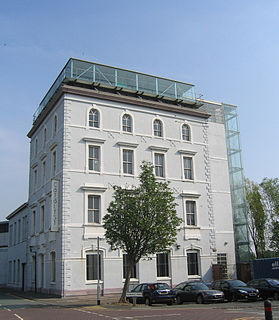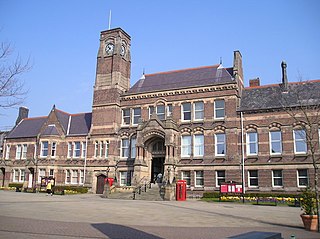
Widnes is an industrial town in the Borough of Halton, Cheshire, England, on the north bank of the River Mersey where it narrows at Runcorn Gap. The town contains 23 buildings that are recorded in the National Heritage List for England as designated listed buildings. Of these, 5 are classified at Grade II*, and 18 at Grade II; Widnes has no Grade I listed buildings. In the United Kingdom, the term "listed building" refers to a building or other structure officially designated as being of special architectural, historical, or cultural significance. Listed buildings are categorised in three grades: Grade I consists of buildings of outstanding architectural or historical interest; Grade II* includes particularly significant buildings of more than local interest; Grade II consists of buildings of special architectural or historical interest. Buildings in England are listed by the Secretary of State for Culture, Media and Sport on recommendations provided by English Heritage, which also determines the grading.
Liverpool is a city and port in Merseyside, England, which contains many listed buildings. A listed building is a structure designated by English Heritage of being of architectural and/or of historical importance and, as such, is included in the National Heritage List for England. There are three grades of listing, according to the degree of importance of the structure. Grade I includes those buildings that are of "exceptional interest, sometimes considered to be internationally important"; the buildings in Grade II* are "particularly important buildings of more than special interest"; and those in Grade II are "nationally important and of special interest". Very few buildings are included in Grade I — only 2.5% of the total. Grade II* buildings represent 5.5% of the total, while the great majority, 92%, are included in Grade II.
Liverpool is a city and port in Merseyside, England, which contains many listed buildings. A listed building is a structure designated by English Heritage of being of architectural and/or of historical importance and, as such, is included in the National Heritage List for England. There are three grades of listing, according to the degree of importance of the structure. Grade I includes those buildings that are of "exceptional interest, sometimes considered to be internationally important"; the buildings in Grade II* are "particularly important buildings of more than special interest"; and those in Grade II are "nationally important and of special interest". Very few buildings are included in Grade I — only 2.5% of the total. Grade II* buildings represent 5.5% of the total, while the great majority, 92%, are included in Grade II.

The Church of St Christopher is in Lorenzo Drive, Norris Green, Liverpool, Merseyside, England. It is recorded in the National Heritage List for England as a designated Grade II* listed building, and is an active Anglican parish church in the diocese of Liverpool, the archdeaconry of Liverpool, and the deanery of West Derby.
Rainhill is a civil parish in St Helens, Merseyside, England. It contains 19 buildings that are recorded in the National Heritage List for England as designated listed buildings. Of these, two are listed at Grade II*, the middle of the three grades, and the others are at Grade II, the lowest grade. The parish was originally rural, and within it was a coaching stop on the turnpike road between Liverpool and Warrington. Following the arrival of the Liverpool and Manchester Railway in the 1830s, the settlements of Rainhill and Rainhill Stoops grew, and merged to become a dormitory residential area. The listed buildings include farmhouses and farm buildings, and large houses that have been converted for later uses. Associated with the railway are its skew bridge and the station. The other listed buildings include churches, a school, an ancient cross, and a water tower.
Formby is a civil parish in Sefton, Merseyside, England. It contains 27 buildings that are recorded in the National Heritage List for England as designated listed buildings. Of these, two are listed at Grade II*, the middle of the three grades, and the others are at Grade II, the lowest grade. Most of the parish is occupied by the town of Formby, and the majority of the listed buildings are cottages or houses and associated structures, the oldest cottages dating back to the 16th century with a timber-framed core. The other listed buildings include churches and associated structures, a former convent, a schoolhouse converted into a restaurant, a set of stocks, and a cross on a roundabout.
Prescot is a civil parish in Knowsley, Merseyside, England. It contains 23 buildings that are recorded in the National Heritage List for England as designated listed buildings. Of these, one is listed at Grade I, the highest of the three grades, and the others are at Grade II, the lowest grade. The parish contains the town of Prescot, which from the middle of the 18th century to the middle of the 19th century was of national importance as a centre of the watch-making industry. This industry is reflected in some of the listed buildings that include workshops, some of which are detached and some are integrated into houses. There is also a large former watch-making factory, and the town's museum contains a reconstructed watchmaker's workshop. The other listed buildings include houses and associated structures, a public house, and two churches.
Whiston is a civil parish in Knowsley, Merseyside, England. It contains nine buildings that are recorded in the National Heritage List for England as designated listed buildings, all of which are listed at Grade II. This grade is the lowest of the three gradings given to listed buildings and is applied to "buildings of national importance and special interest". The parish is partly residential, and partly rural. The listed buildings include farmhouses and farm buildings, houses, structure sat the entrance to a former country house, a church, and a railway bridge.
Cronton is a civil parish in Knowsley, Merseyside, England. It contains eight buildings that are recorded in the National Heritage List for England as designated listed buildings, all of which are listed at Grade II. This grade is the lowest of the three gradings given to listed buildings and is applied to "buildings of national importance and special interest". The parish includes the village of Cronton, and is otherwise rural. Apart from a medieval cross base and a set of stocks, the listed buildings are all houses and associated structures.
Billinge Chapel End is a civil parish in St Helens, Merseyside, England. It contains 13 buildings that are recorded in the National Heritage List for England as designated listed buildings. Of these, two are listed at Grade II*, the middle of the three grades, and the others are at Grade II, the lowest grade. The parish contains the village of Billinge and surrounding countryside. The listed buildings consist of houses, farmhouses, farm buildings, and two churches with associated structures.
Huyton with Roby is a district in the Metropolitan Borough of Knowsley, Merseyside, England. Formerly the civil parish of Hyton-with-Roby, it contains the settlements of Huyton and Roby. The district contains 25 buildings that are recorded in the National Heritage List for England as designated listed buildings. Of these, one is listed at Grade II*, the middle of the three grades, and the others are at Grade II, the lowest grade.
Knowsley is a civil parish in the Metropolitan Borough of Knowsley, Merseyside, England. It contains six buildings that are recorded in the National Heritage List for England as designated listed buildings. Of these, two are listed at Grade II*, the middle of the three grades, and the others are at Grade II, the lowest grade. The parish is dominated by Knowsley Hall, which is listed. The other listed buildings are a church, a former vicarage, a farmhouse, a lodge, and a school later converted into cottages.

The Church of the Holy Family is attached to the service wing of Ince Blundell Hall, near the village of Ince Blundell, Sefton, Merseyside, England. It is both an estate church and an active Roman Catholic parish church in the Archdiocese of Liverpool. The church was built in 1858–60, it was designed by J. J. Scoles, and it contains paintings by Gebhard Flatz. It is recorded in the National Heritage List for England as a designated Grade II* listed building.
Litherland is an area to the north of Liverpool in Sefton, Merseyside, England. It contains five buildings that are recorded in the National Heritage List for England as designated listed buildings, all of which are listed at Grade II. This grade is the lowest of the three gradings given to listed buildings and is applied to "buildings of national importance and special interest". The area is almost completely residential, and the listed buildings consist of two churches, a Methodist mission, a former Sunday school, and a farmhouse.
Lydiate is a civil parish and a village in Sefton, Merseyside, England. It contains 14 buildings that are recorded in the National Heritage List for England as designated listed buildings. Of these, two are listed at Grade II*, the middle of the three grades, and the others are at Grade II, the lowest grade.
Maghull is a civil parish and a town in Sefton, Merseyside, England. It contains ten buildings that are recorded in the National Heritage List for England as designated listed buildings. Of these, one is listed at Grade II*, the middle of the three grades, and the others are at Grade II, the lowest grade.
Melling is a civil parish and a village in Sefton, Merseyside, England. It contains 11 buildings that are recorded in the National Heritage List for England as designated listed buildings. Of these, one is listed at Grade II*, the middle of the three grades, and the others are at Grade II, the lowest grade. Apart from the village of Melling, the parish is rural. The listed buildings include houses, farms and associated buildings, a church and associated structures, and an ancient cross.
Bold is a civil parish in St Helens, Merseyside, England. It contains six buildings that are recorded in the National Heritage List for England as designated listed buildings, all of which are listed at Grade II. This grade is the lowest of the three gradings given to listed buildings and is applied to "buildings of national importance and special interest".
Eccleston is a civil parish in St Helens, Merseyside, England. It contains seven buildings that are recorded in the National Heritage List for England as designated listed buildings. Of these, four are listed at Grade II*, the middle of the three grades, and the others are at Grade II, the lowest grade.
Aughton is a civil parish in the West Lancashire district of Lancashire, England. It contains 15 buildings that are recorded in the National Heritage List for England as designated listed buildings. Of these, one is listed at Grade I, the highest of the three grades, one is at Grade II*, the middle grade, and the others are at Grade II, the lowest grade. The parish is partly residential, and partly rural. The listed buildings consist of churches, houses, farmhouses and farm buildings, two cross bases, boundary stones, and a war memorial.










